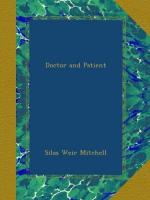I have named one of the most illustrious of physicians, Sydenham, as among the great Englishmen who brought to their work the clearest perception of how nature was to be best aided. He will answer admirably to exemplify my meaning.
Sydenham was born in 1624, and lived in and through the wild periods of Charles I. and Cromwell, and was himself a stanch republican. He more than any other in his century decisively taught caution as to mere medication, and sedulously brought the clear light of common sense to bear upon the practice of his time. It is interesting to note, as his biographer remarks, that his theories were often as worthless as his practice was good. Experience taught him to do that for which he felt forced to find a reason, and the reason was often enough absurd. “The contrast gives a fine light and shadow effect in his biography."[2]
[Footnote 2: R.G. Latham, p. xxxvi.]
His systematic beliefs were ofttimes worthless, but great acuteness in observation was apt to lead him to do wisely in individual cases what was at variance with his creed. Speaking of Hippocrates, he says, “His system led him to assist nature, to support her when enfeebled and to the coercion of her when she was outrageous.”
As to mere drugs, Sydenham used them in what was for his day an extremely moderate fashion, and sagaciously limited in the old and young his practice as to bleeding, which was then immensely in vogue. The courage required to treat smallpox, measles, and even other fevered states by cooling methods, must have been of the highest, as it was boldly in opposition to the public and private sentiment of his day. He had, too, the intelligence to learn and teach that the Jesuit bark, cinchona, was a tonic as well as the master of the agues, so common in the England of his time.
He is at his best, however, in his statement of how he treated individual cases, for then his written theories are given to the winds, or the practice is far beyond the creed in its clear common-sense value.
Thus, horseback exercise he constantly speaks of. He tells you of a friend who had been much dosed by many for dyspepsia, and how he bade him ride, and abandon drugs, and how, after a thousand miles of such riding, he regained health and vigor. See how this wise man touches the matter of gout: “For years a man has feasted; has omitted his usual exercises; has grown slow and sluggish; has been overstudious or overanxious, etc.” Then he reasons about “smothering the animal spirits, which are the primary instruments of concoction,” and so on, but at last he says, “We must look beyond medicines. Wise men do this in gout and in all other chronic diseases.” And what does he advise? Here is the substance of what he says. A gouty man must be moderate, not too abstinent, so as to get weak. One meat is best; mixtures are bad. A milk diet “has prevailed,” only bread being added, but it must be rigid and has




